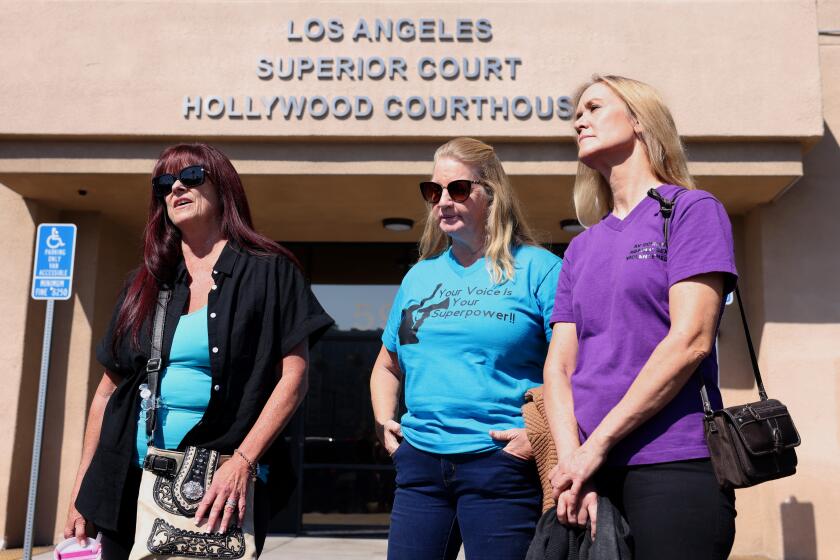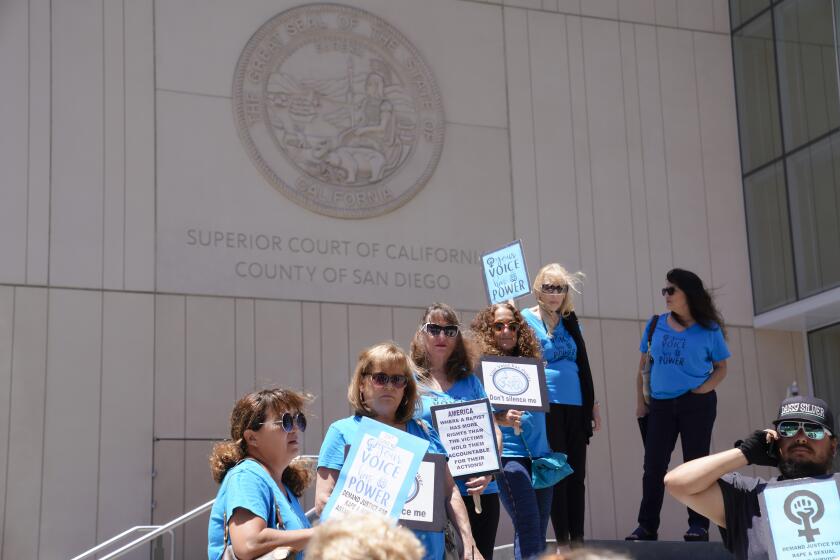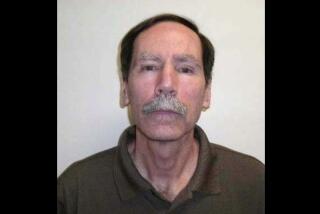Residents vow to fight back after ‘Pillowcase Rapist’ is ordered released in their community

- Share via
Red signs dot Pearblossom Highway, marking part of the route sexual predator Christopher Hubbart probably will take when he moves into the Antelope Valley in the near future.
The signs — featuring graphics of two pairs of hands and the phrase, “We need your help!” — were placed by advocate Mary Jeters and a group of local residents still fighting Hubbart’s court-ordered placement in their community.
“I’ve had a few people ask why we’re doing this after the judge’s decision, and it’s because this fight isn’t over,” Jeters said. “We want to push to stop the further encroachment of sexual predators.”
Antelope Valley locals are rallying to protest the potential placement of the latest violent sexual predator in the area, the ‘Pillowcase Rapist.’
Two weeks ago, Los Angeles County Superior Court Judge Robert Harrison ruled that Hubbart, known as the “Pillowcase Rapist” for his brutal sexual assaults on women in the 1980s and ‘90s, would be placed into the small community of Juniper Hills.
Jeters and her group, No SVP’s in the Antelope Valley, are hosting a rally Saturday at the Juniper Hills Community Center beginning at noon. They have two stated goals: bring awareness to sexually violent predators being “dumped” in the area, and prevent it from happening again.
Jeters said local representatives, including Palmdale’s mayor and City Council, are expected to attend, along with a few hundred residents.
This is the second time Hubbart has been placed in the Antelope Valley. In 2014, he was housed in the Lake Los Angeles area near Palmdale under a conditional release program. He lived there for two years before he was remanded back to Coalinga State Hospital after violating the terms of his release.
His placement then was fiercely contested by protesters, who later celebrated his return to custody.
Since 2003 the California Department of Health Services has paid a vendor $96 million to oversee the release of 56 sexually violent predators — an average cost of about $1.6 million per predator, according to a recently released audit.
In 2021, an L.A. County Superior Court judge released convicted sex offender Calvin Lynn Grassmier into the town of Littlerock, despite local opposition. Lawtis Donald Rhoden, who sexually assaulted multiple underage girls, was placed that same year in an unincorporated area near Lancaster.
In the case of Grassmier, residents protested upon his arrival in September 2021. Some wore masks of Heath Ledger’s depiction of the Joker with exaggerated bloody smiles and held signs reading, “Sexually violent predator not welcome here!!!” and “Keep our community safe from SVPs.”
Cynthia Farrow lives directly across from Grassmier and said she monitors when he attempts to leave the property, even when taking out the trash or checking the mail.
Christopher Hubbart was committed to a state hospital for much of the last 24 years after he admitted to 44 sexual assaults. He would cover his victims’ heads with pillowcases while raping them.
“I scream at him to ‘get over to your side,’” said Farrow, who lives with her husband, Gary. “These are violent individuals who make our homes and neighborhoods much less safe.”
Jeters and Farrow said they will consider similar protests whenever Hubbart is moved into Juniper Hills.
Until then, Jeters is attending court hearings regarding the terms of Hubbart’s release.
“We’re going to continue to monitor and fight,” Jeters said. “Even if it seems like us screaming into the wind, we’ll be out there.”
More to Read
Sign up for Essential California
The most important California stories and recommendations in your inbox every morning.
You may occasionally receive promotional content from the Los Angeles Times.














